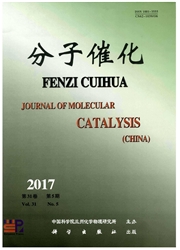

 中文摘要:
中文摘要:
以五水硝酸铋(Bi(NO3)3·5H2O)和溴代十六烷基吡啶(CPB)为原料,通过水热法合成溴氧化铋(BiOBr)光催化剂,并在pH=3.3的条件下分别用0.01mol/L、0.1mol/L、0.3mol/LNaF溶液对其进行浸泡氟化处理得新催化剂BiOBr-F0.01、BiOBr-F0.1和BiOBr-F0.3.运用XRD(X-射线衍射)、SEM(扫描电镜)、UV-Vis DRS(紫外-可见漫反射光谱)、XPS(X-射线光电子能谱)、FL(荧光光谱)等技术对催化剂的物理结构及性质进行表征并研究了其在可见光(λ≥420nm)下对有机染料罗丹明B(Rhodamine B,Rh B)的催化降解活性.结果表明,随着NaF浓度增加,催化剂的结构及性质均发生一定程度的改变.氟化使得BiOBr对RhB的矿化能力减弱;但BiOBr-F0.1使RhB褪色加快.RhB在降解过程中涉及到超氧自由基(O2.-)、羟基自由基(·OH)及空穴(h+)氧化,矿化率减小归因于活性物种产量降低,BiOBr-F0.1使褪色加速则是加快了RhB的脱烷基过程,使最大吸收峰快速蓝移.
 英文摘要:
英文摘要:
Bismuth bromide (BiOBr) photocatalyst was hydrothermally synthesized and bismuth nitrate pentahy- drate (Bi( NO3 )3 · 5H2O) and bromohexadeeyl pyridine (CPB) were used as the reactants. The synthesized BiO- Br was soaked in NaF solution of 0.01 mol/L, 0.1 mol/L and 0.3 mol/L to obtain the three fluorided catalysts, named BiOBr-F0.01 , BiOBr-F0.1 and BiOBr-F0.3 , respectively. The samples were characterized by XRD (X-ray dif- fraction), SEM (Scanning electron microscopy), UV-Vis DRS (UV-Vis diffuse reflectance spectra), XPS (X-ray photoelectron spectroscopy) and FL (Fluorescence spectrum). The photocatalytic activity of the catalysts was eva- luated by the degradation of an organic dye, Rhodamine B (RhB) under visible-light ( A ≥ 420 nm) irradiation. The results indicated that the structures and properties of the catalysts were changed with the concentration of NaF increased. For example, Mineralization of RhB was decreased after fluoride modification, while the decolorization rate of RhB was improved when using BiOBr-F0.1 as catalyst. Reactive oxygen species (ROS) participating in the degradation of RhB were examined and the generation of superoxide radical ( 02 .- ), hydroxyl radical ( · OH) and photogenerated hole (h+) was identified in the photocatalytic system. Compared with BiOBr, the mineralization rate of BiOBr modified by NaF decreased, which was attributed to the decreased production of ROS; the decoloriza- tion of RhB was accelerated using BiOBr-F0.1 due to the fast dealkylation making the maximum absorption peak of RhB blue-shift.
 同期刊论文项目
同期刊论文项目
 同项目期刊论文
同项目期刊论文
 期刊信息
期刊信息
